A fortress of smog
Decades of lackluster policies fail to loosen the chokehold of toxic air on Lahore once again
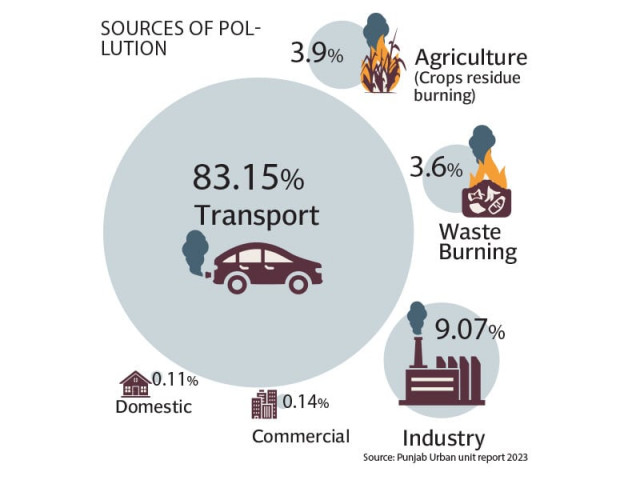
While school children across the globe are usually off from school during the holiday season only, those studying in Pakistan's most populous province are set free during the smog season too. However, unlike festive occasions, this season brings nothing to celebrate.
As the choking air settles into the atmosphere, the wheezing of an asthmatic loved one aggravates, the buzz of outdoor activities is killed while life seems to revolve around a big box of surgical masks, or an air purifier tucked in a corner of the home.
With eyes stinging, voices cracked by dry air, smell dulled by congestion, and hearing strained by infections, the citizens of Punjab are imprisoned in a concentration camp of toxic air, where government inefficacy is the silent killer.

Source: EPA and IQAir
Since the past 15 years or so, smog has continued to be a paramount seasonal suffering for locals in Punjab, who have now almost adapted to the perpetual cloud of toxic air which surrounds them from October to February each year.
Although the current Chief Minister of Punjab assumed office this year, her party, the Pakistan Muslim League-Nawaz (PML-N), has held power for most of the years since 2008, during which air pollution levels steadily rose, ultimately leading to the current smog crisis.
According to IQAir, a Switzerland-based pollution watchdog, Lahore's current air quality has been declared hazardous, with the concentrations of the primary pollutant PM2.5 reaching levels which are 35.4 times more than the quantity declared safe by the World Health Organization (WHO)'s annual air quality guidelines
Although the Punjab government has announced the Smog Action Plan while declaring the environmental emergency a "crisis", experts believe that no green lockdown, electric bikes initiative or "climate diplomacy" move with India, can save Punjab from once again drowning in the sea of choking air in the coming months until or unless the state authorities consistently implemented a long-term plan of action for cleansing the air of Lahore, which has emerged to be the second most polluted city in the world.
While expressing his concerns over the Punjab government's smog reduction plan, Ahmed Rafi Alam, an environmental lawyer, was of the opinion that the plan replicated the government's past efforts, which had proven fruitless. "The plan neglects vital sectors like health since pulmonologists are absent from the government committee," highlighted Alam.
Similarly, Maryam Shah, Head of Communication at the Pakistan Air Quality Initiative shed light on the fact that the primary reason behind the province's worsening smog crisis was the overreliance on private transportation. "Vehicles are the primary source of smog, which cannot be controlled until the government upgrades the public transportation system," implored Shah.
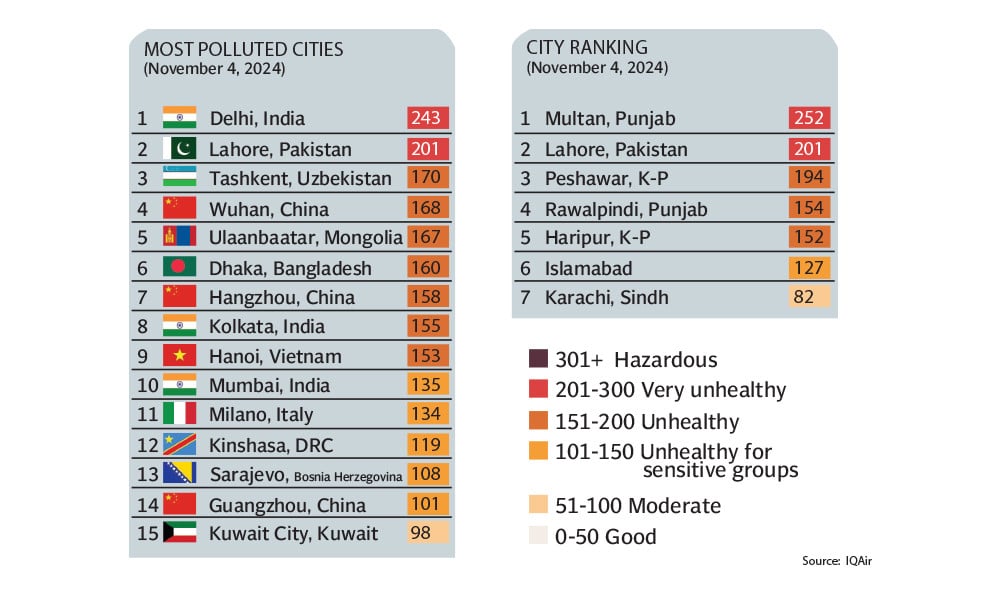
Source: IQAir
What is smog?
Smog, once simply defined as a blend of smoke and fog, has evolved into a far more dangerous form of pollution.
According to Energy Education at the University of Calgary, modern smog is a complex cocktail of harmful pollutants, including particulate matter (PM) and ground-level ozone (O3), mixed with carbon monoxide (CO), nitrogen oxides (NOx), sulfur dioxide (SOx), and volatile organic compounds (VOCs) largely a byproduct of human activities like the burning and extraction of fossil fuels.
Airly, an air quality monitoring service based in Krakow, points to the surge in vehicles on the road as a significant contributor to this worsening crisis in many countries.
Why does Lahore choke?
If despite the government's yearly plans, policies and assurances, smog continues its chokehold over Lahore, the most polluted city in the province, then surely something must be wrong in the state's handling of the seasonal epidemic.
According to Dawar Butt, an expert in environment and public policy, Punjab's excessive fuel-burning activity through transportation, industries, and power plants acted as the primary contributor to air pollution. "All these three sectors use substandard fuel, which exacerbates the issue. Since India uses Euro 5 and 6, we too must make it mandatory to use high-quality fuel.
In addition, it will be necessary to outlaw the use of diesel and outdated automobiles that emit a lot of smoke," urged Butt who felt that until or unless the trend of private transportation was discouraged, the smog crisis would continue.
Data indicates that there has been no improvement in the smog crisis over the past one year in Lahore, despite the Punjab government's implementation of a smog mitigation plan. Lahore has consistently topped the list of the world's most polluting cities since mid-October.
In particular, on October 27 the level of Air Quality Index (AQI) cast doubt on the government's assertions that it was taking action to combat smog. In the last week of October, the city's AQI reached a peak reading of 707 between 7 am and 8 am before gradually dropping to 350 by 11am.
In 2023, Lahore's atmosphere was deemed good for only three days, satisfactory for 42 days, and unsatisfactory or unhealthy for a whopping 320 days. This year, from January 1 to October 30, Lahore's air quality showed minimal improvement, with four good days, 12 satisfactory days, and the remaining days classified as harmful or extremely harmful.
"The government's smog action plan cannot be expected to yield instant results, but it will produce positive outcomes in the long run with consistent effort," said Shah, who felt that Lahore too should implement similar legislation as Delhi, which prohibits the entrance of cars older than ten years.
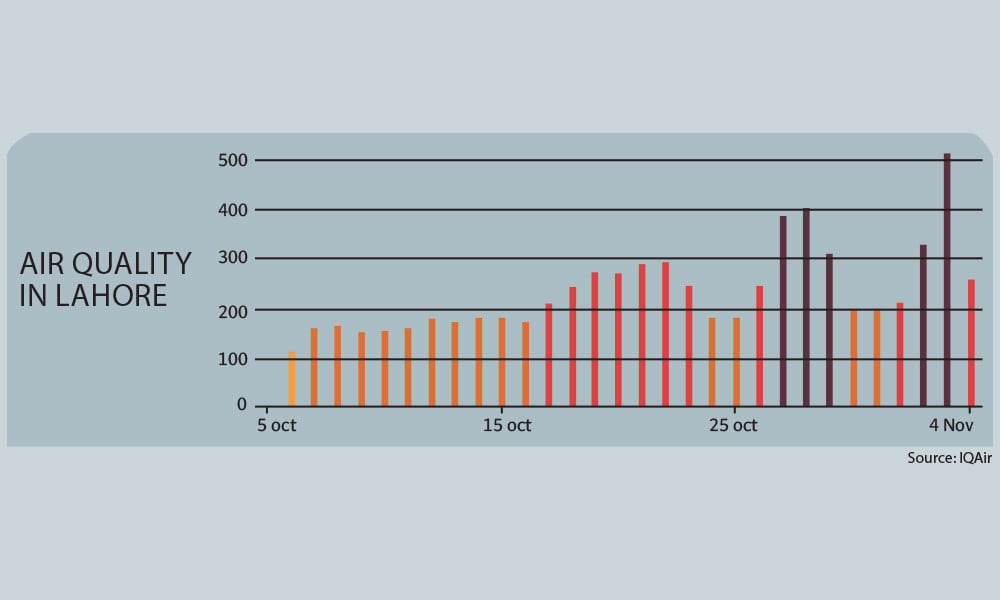
Source: IQAir
Do we have a health crisis?
Apart from the perpetually grey skies and hazy atmosphere perhaps the most profound impact of smog appears to be on the health of the inhabitant citizens especially those with chronic illnesses.
According to Airly, persistent exposure to smog can lead to the development of allergies, asthma, respiratory failure, decreased immunity, cardiovascular, and neoplastic diseases.
"Due to smog, many patients are coming to the hospitals these days with eye issues and respiratory problems. The risk of pneumonia and bronchitis is also much higher among those patients who already have weakened lungs due to a chronic condition.
The infection causes a dry cough and a burning sensation in the chest while there is also blood in the saliva. In such conditions, the breathing capacity of the lungs also decreases. Hospitals are getting crowded these days," informed Dr Mohammad Riaz, a pulmonologist at a government hospital at Yakki gate.
According to Dr Saqib Shaikh, a thoracic and pulmonary specialist, smog causes inflammation in the respiratory tract, leading to difficulty in breathing. "Smog consists of components of carbon, sulfur and other various chemicals which are very dangerous for the health of humans and animals.
Due to this, asthmatic patients suffer a lot. Constant exposure to smog increases the likelihood of lung diseases while sometimes cancer can also develop. At first there is a cough, and then sputum and phlegm begin to flow, causing the airways to deteriorate due to inflammation," explained Dr Shaikh.
Dr Shaikh further claimed that apart from the elderly, smog was also very dangerous for small children, who were increasingly targeted by various diseases. "If precautions are not taken during smog, minor health issues can lead to big diseases. People with pre-existing chronic diseases can develop further complications including death," he warned.
Which areas suffer the most?
The dense, choking air of Lahore, often bringing the city to a grinding halt, is particularly pronounced in ten hotspots, including Shimla Pahari, Badami Bagh, and Gulberg. According to Jehangir, the Environment Secretary, these areas are particularly prone to smog accumulation, exacerbated by the city's unchecked urban sprawl and pollution sources.
Although not all areas in Lahore have air quality monitoring devices, data taken from the few government and private air quality monitors revealed that other areas like Johar Town, Syed Maratib Ali Road, Town Hall, University of Punjab, Kot Lakhpat Factory Area, and Jail Road, were also among the most polluted areas in the city over the past week.
While the provincial government has committed to enforcing stricter regulations and limiting construction and commercial activities to combat the worsening crisis, those closely following the situation understand that it is not merely the words that hold significance at this stage; rather, it is the actions taken that will prevent the environmental disaster from recurring each year.
Is it too little, too late?
As the provincial capital grapples with an air quality crisis, officials tout progress in combating pollution, but the reality on the ground tells a very different story. According to Ali Ijaz, District Officer at the Environmental Protection Institute Lahore, three out of 156 brick kilns in Lahore have been dismantled, while the remaining kilns have all been moved to zigzag technology.
"In a similar vein, 500 of the 560 small and large industrial units have installed emission control systems. Recent statistics indicate a significant decline in pollution contributions from brick kilns and industrial units in Lahore," claimed Ijaz.
While Ijaz's claims of sustainable industrial developments might be valid, a 2023 report by the Urban Unit revealed that transportation was the primary contributor to Lahore's air pollution, responsible for 83.15% of total contamination levels. Industry accounted for 9.07%, followed by agriculture at 3.9%, waste incineration at 3.6%, commercial activities at 0.14%, and domestic sources at 0.11%.
"There are a total of 4.5 million motorcycles registered in Lahore while 1,800 more motorcycles are registered every day. Similarly, there are 1.3 million three-wheeler and four-wheeler vehicles of all categories in Punjab, which are increasing by 100,000 every year. It is alarming to note that the total number of vehicles are increasing year by year," reported Raja Jahangir, the Environment Secretary, who further claimed that new vehicles with converters emitted less smoke than motorcycles.
Jahangir also informed that 500 electric buses had been procured by the government on the instructions of Chief Minister Punjab Maryam Nawaz while 20,000 electric bikes had also been ordered.
Opposing Jahangir's assurances was the Pakistan Air Quality Professionals Group, consisting of meteorology, law, economics, health and technology experts, who have termed the Punjab government's smog mitigation plan inadequate.
Specifically, they pointed out the lack of public consultation for the Punjab Clean Air Plan (2023) and Smog Mitigation Plan for Punjab/Lahore (2024), which in their opinion, is a critical oversight.
Where does Lahore stand globally?
During the past one week, Lahore's Air Quality Index touched 514, with the majority of days oscillating between "very unhealthy" and "hazardous" air days, surpassing India's New Delhi, which reported a highest AQI of 319 during the last week.
Although in 2018, Lahore ranked 10 in the list of the world's most polluted cities, six years later in 2024, the city has topped the list competing with New Delhi, which too notoriously holds the same rank.
The degree of danger is such that the health recommendations on the IQAir website have instructed citizens to wear a mask when outside, close windows in the house and avoid spending time outdoors alongside investing in air purifiers.
Is there any solution?
There was once a time when people used to joke about buying oxygen in a bottle. Considering the current state of air pollution in Punjab perhaps the humorous hypotheses could become the reality for the coming generations if the state authorities continue their sporadic and sluggish policies against air pollution.
According to a report published by the UN Environment Programme, reducing air pollution required a comprehensive plan of action which involved reducing the burning of coal and biomass, conserving energy and promoting public transportation.
"High-quality public transportation must be made available and also encouraged. Lower fares should be offered during peak hours in the morning and evening, while seniors and students should receive special discount cards. On weekends, public transportation to entertainment venues needs to be free or inexpensive," said Butt, an expert in environment and public policy. (With additional input by Mahnoor Tahir Ali)


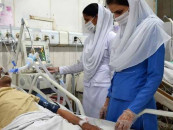


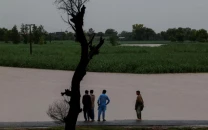













COMMENTS
Comments are moderated and generally will be posted if they are on-topic and not abusive.
For more information, please see our Comments FAQ